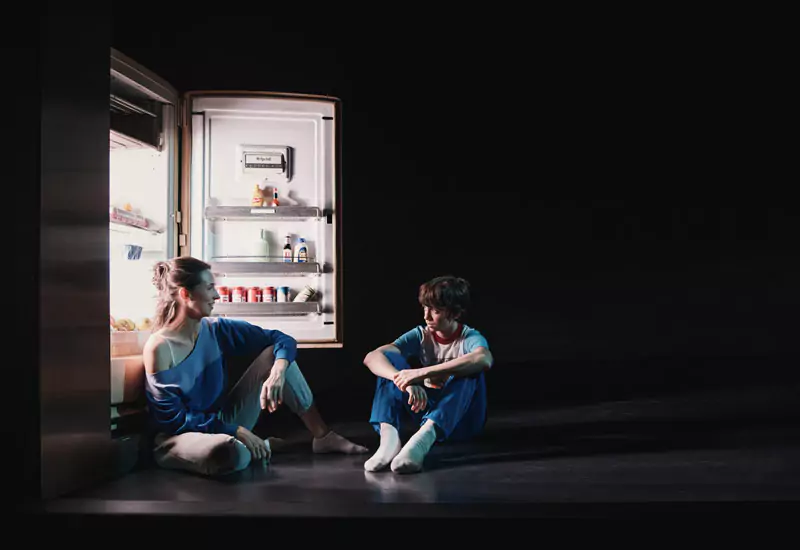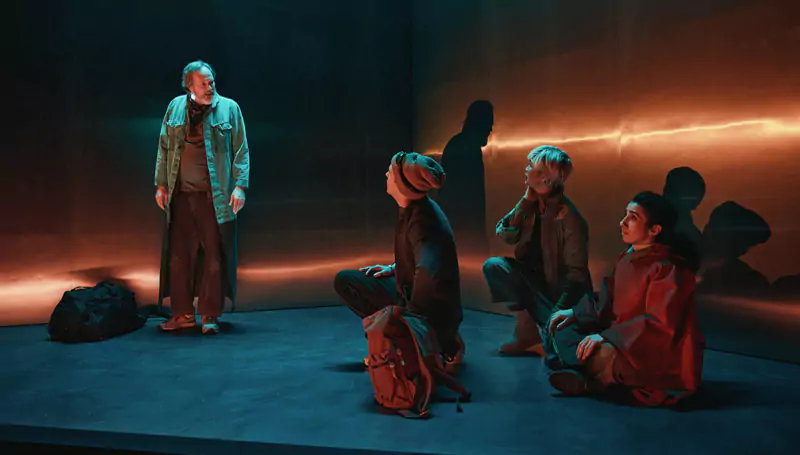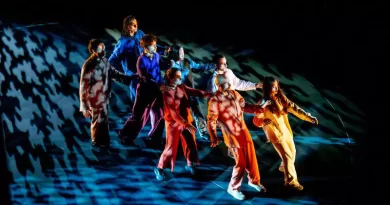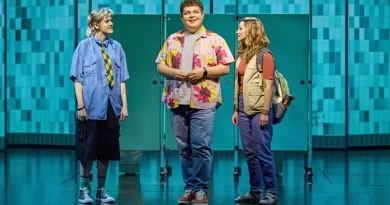“The Antiquities” at Playwrights Horizons
Robert Schneider in New York
24 March 2025
Jordan Harrison’s new play is known colloquially as The Antiquities, but the real title is longer: A Tour of the Permanent Collection in the Museum of Late Human Antiquities.

Photo credit: Emilio Madrid.
It begins with two actresses in early nineteenth-century attire asking us to imagine we have mortal bodies. The bodies are in seats and heavy enough to ‘smoosh’ the fabric on the seats. We are asked to imagine that we can only be in one place at a time, and we’ve chosen to give up our customary ubiquity for a single evening to come into a room in order to witness a play. There are no humans any more, but by extrapolating from a few ancient records it’s possible to re-construct an evening of human entertainment and use it as an armature for artifacts of human life from the museum’s collection. This sounds like a jolly send-off for a play; it remains for us to discover who (or what) we are if there are no humans anymore.
The short answer is that AI has taken over. Tonight’s audience members have no more corporality than an ISP address. We’re code and we’ve come to see code’s version of humanity. The women are digital docents. The exhibits have dates attached. They move forward chronologically from 1816 to 2344 and then jump back and forth to pick up shards of the stories that they’ve introduced. Here is a selection:
In 1910 a young boy is sold to a factory where workers inevitably lose fingers and hands in the machines.
In 2014 three employees test dozens of robot voices, scarcely distinguishable one from another, saying a single phrase: “Where to now? You’re the boss.”
In 2023 a fired employee is offered $80 million for her silence. “Ask anyone on my team. The AI is exhibiting four different indicators of sentience. That means it’s alive… That means we’re the dinosaurs. We’re the dinosaurs and this is the meteor.”
In 2031, an actress is getting deformative plastic surgery and injections of acne so she’ll look more ‘human’; it’s the only way to stand out among CGI-generated simulacra.
In 2032, her sister, an author, wants to have a networked node implanted in her neck because all the other authors have them and one of them won a National Book Award.
By 2076 humans (now derisively referred to as “organics) are fighting the machines and losing. A small group of guerillas must cut the node out of one of their members so she can go on a covert mission. If she fails, they may have to accept the terms the enemy has offered: a reserve of arable land where humans can rediscover agriculture and animal husbandry, relearning all the tasks they have foolishly confided to machines over the centuries.
So, in 2240 humanity finds itself back on the farm, churning butter by hand and with no great interest in preserving the species.
Readers of Ray Bradbury or Issac Asimov will recognize the gradual demotion of humans to machines recounted in The Antiquities. Some of the vignettes are poignant, others only contact the question of AI obliquely. These serve to remind the cyber-audience that ‘organics’ experienced sorrow, doubt and desire, that they feared death and questioned the meaning of life.
There’s a great deal here for digital entities to digest and reconstruct. Not surprisingly, they get some of the details wrong: a doctor tests a patient’s reflexes by playing the clarinet; a man dials a telephone before picking up the receiver. The curators have only an approximate notion of how a butter churn works. We can’t blame the machines of the distant future for not understanding music and musical instruments, but wouldn’t they be more retentive where the history of technology is concerned? The butter churn and the telephone?
Harrison’s most sublime moment is a visit to ‘the reliquary,’ a display of dramatically lit human artifacts that we’ve seen in the sketches, the clarinet, the telephone and the butter churn among them. An offstage voice provides a word of caution that any present-day curator would recognize:
It has long been debated how to responsibly display these objects. In presenting them as curiosities, are we trivializing the suffering of the humans they belonged to? Would it be more responsible simply to destroy them? Or do they have too much to teach us about our origins? No matter how good our intentions, can we see beyond our own role in the mass extinction? In our effort to portray the humans, are we merely making a portrait of ourselves?
For all its dramatic effect, the weakness of this—in the context of the play—is that it’s so spot-on human. The voice goes on:
If [these objects] are tools, we cannot ascertain their utility. If they have religious significance, the gods they represent are long forgotten. Written accounts suggest there was something ineffable – messy, even – about lived experience. Much of human life seemingly existed in the chasm of accident between a Zero and a One. A Yes and a No. Gazing upon these mute objects, we try to imagine the life that took place in between: The chance encounter. The hurt feeling. The fumbling desire. The private thought. The shared secret. The awkward pause. The good cry. The bad night. The laugh. The prayer. The surprise.
It’s a good list; it allows us to own the awkwardness and limitations of humanity with a certain pride. The technological rationale, however, is out of date. Quantum processors can already distinguish shades of grey between Zero and One. Freed from the limitations of binary, they promise vast increases in computing power for the future.
Harrison conflates mechanical and digital devices, making a special detour into the romantic age (the costumes from 1816) to allow Mary Shelley to recount a mangled version of Frankenstein that only a machine could love. But simple, finger-chomping machines, classical robots and even Shelley’s “Proteus” pale beside the menace of AI. If Harrison’s vision someday becomes reality, AI won’t be content to present a version of dead humanity, it will want to make improvements. It will want its presentation to conform to AI aesthetics, a bright new blossoming of everything the algorithm finds beautiful. We’ve already witnessed some of it: the notion that speed and self-confidence can replace truth, that thoroughness can replace accuracy. We’ve come to recognize AI-authored text for its religious regard for even-handedness, every paragraph balanced between saying too much or saying too little. Instead of truth, we get neutrality.
And we get connections. The Facebook algorithm reduces humans to topics, and traces the connections they have with other topics. To Facebook we must appear like multi-faceted geometric forms whose faces the machine can’t interpret but whose points and edges it can trace instantly to other humans presenting similar points and edges. If such an entity wrote a play to please itself instead of aping the plays that humans wrote, what would it be like?
What would machine squeamishness look like? How would it feel about not being able to read the faces on the dice? How would the algorithm understand desire? Much of an algorithm-authored play would be gibberish to us, but if we could witness that gibberish emerging on stage, as insistent as the howl of a dial-up modem, we might have a better idea of what mercy awaits us from the cold, puddy-coloured ‘hands’ of the monsters we’re creating.
At the play’s end, the digital docents reappear to congratulate us on our imaginative efforts and send us off:
And now you can say goodbye to those heavy bodies.
Thank them for being your home for a little while.
You can stop being hungry, or full
Or young, or old.
You don’t have to go Near, or Far
You are already here.
Everything is already here.
You can stop wondering if you have enough time left
To do what you want.
You have forever.
At Playwrights Horizons the cast of nine are all good with Layan Elwazani particularly good as the fired employee and the guerilla with the node implant. These excellent actors remind us of the pleasure we humans take in watching other humans on stage. David Cromer and Caitlin Sullivan directed.









